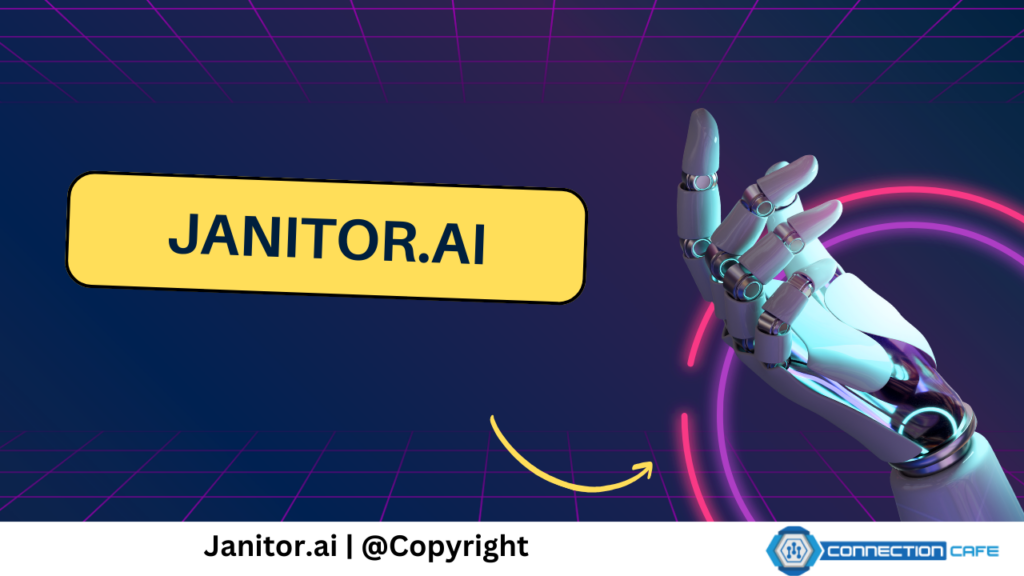If you’ve used tools from open.ai before, you might know about janitor.ai (also called Janitor AI). But what is janitor.ai, and what does it do?
This guide will help you understand the Janitor AI tool and show you how to use it for different tasks, like web scraping. Let’s get started.
What is Janitor.ai?
Janitor.ai is a sophisticated AI chatbot. It uses natural language processing (NLP) and machine learning to automate tasks, improve data interaction, and more.
This tool is very flexible. It can comprehend and answer user questions. Additionally, it performs tasks such as:
- Cleaning data
- Formatting data
- Naming columns
- Quickly counting different variable combinations
- Cross-tabulating data

How Does Janitor AI Work?
Janitor AI uses a combination of high-tech methods, mainly these:
Natural Language Processing (NLP)
NLP helps Janitor AI grasp the meaning and purpose of your words, even when they are unclear or casual. It examines elements such as sentence structure, meanings, and the overall context to understand your questions, commands, or requests.
Machine Learning (ML)
Janitor AI utilizes machine learning algorithms that have been trained on extensive collections of texts and code. This training allows it to recognize patterns, learn from interactions, and enhance its answers over time. For instance, its ability to reflect human emotions and respond with empathy improves as it engages more with users in immersive mode.
Generative AI
This technology enables Janitor AI to produce new text, converting what it understands from your inputs into suitable responses. It can create various creative outputs like poems, scripts, code, or personalized stories, depending on your requirements.
Chatbot Features
These specific attributes make Janitor AI interactive and captivating. It can answer your questions, engage in conversations, and execute tasks as directed.
API Integration
For accessing immersive mode or other sophisticated features, Janitor AI often needs to connect with external apps or services via APIs. This connection facilitates the exchange of data and enhances its capabilities.
What Is Immersive Mode Janitor AI?
Immersive mode in Janitor AI enhances your interaction, making it more human and captivating.
Immersive mode includes:
- Expressive Language: Picture an AI that is clever and humorous, able to chat in a way that feels real and engaging. This mode broadens the variety of language it uses, making conversations with Janitor AI seem more natural.
- Emotional Intelligence: Gone are the impersonal, mechanical responses. With immersive mode, Janitor AI reflects your feelings, offering responses filled with empathy and understanding. It responds as a human would.
- Deeper Connections: The blend of expressiveness and emotional awareness leads to a deeper, more personal chatting experience. This is ideal for fostering connections, having significant discussions, or crafting impactful stories.
Immersive mode is also versatile for creating interactive chatbots and digital companions.
Setting Up an API on Janitor AI
Setting up the API on Janitor AI is simple but may vary slightly by version and features. Here’s what to do:
Get an API Key
You need an API key for features like immersive mode. Each user gets their own, though some features need special keys.
If using OpenAI models, visit https://openai.com/ and sign up. Create an API key under your account settings.
Some Janitor AI versions let you generate a key directly on the platform. Look in your settings or the manual for details.
Adjust Janitor AI Settings
After getting your API key, open your Janitor AI dashboard. Choose the character for immersive mode.
Click “Chat with” then “Settings.”
Find the API setup area and pick your API source (OpenAI or another).
Enter your API key in the field provided and confirm.
Check and Test
Some versions might need more setup or checks. For this, go to the Janitor AI site and select “settings.” Go to the configuration area and input your OpenAI API key. Now, you’re set to use Janitor AI.
How Does Web Scraping with AI Work?
Web scraping is when you gather data from websites. It uses automated methods to pull information from web pages, usually in a neat format. This data is then analyzed, processed, or saved. Web scraping helps in many areas like data mining, checking competitors, research, comparing prices, and more.
Web scraping with AI involves using artificial intelligence to get information from websites. Normally, web scraping uses coding scripts to go through web pages, find important data, and take it. Adding AI to this process improves how well it can pull out data, making it smarter and more flexible.
Here’s a simple explanation of how web scraping with AI works:
- URL Input: It starts by choosing the URLs of the websites or pages you want to scrape.
- HTML Parsing: The HTML setup of the pages is analyzed to find and take out important content.
- Content Understanding: AI, especially Natural Language Processing (NLP), helps understand the text on the pages.
- Entity Recognition: NLP tools can spot things like names, places, and dates in the text.
- Image Recognition: For pages with pictures, AI can recognize and pull out details from these images.
- Multimedia Content Processing: AI can also handle video or audio content to find useful data.
- Machine Learning Training Models: Machine learning can learn patterns to recognize and pull specific data from pages.
- Adaptive Scraping: AI can adjust to changes in how websites are set up, which helps it handle different web designs.
- JavaScript Rendering: Some sites use JavaScript to show content dynamically. AI can run this JavaScript to scrape content that loads this way.
- Feedback Loop: AI can learn from what works or doesn’t, improving how it gathers data as it goes.
What Is a Janitor AI Proxy?
A Janitor AI proxy serves as a middleman between you and the Janitor AI API. It lets you use the API’s features without direct interaction.
A Janitor AI proxy is useful in various ways:
- It simplifies API usage: Proxies make it easier to interact with the API, which is useful if you’re not familiar with APIs.
- It adds extra features: Some proxies include additional functions like caching, rate limiting, and authentication.
- It boosts performance: By caching commonly used data and reducing API requests, proxies can enhance the performance of your application.
What Is a Janitor AI Reverse Proxy?
Normally, using Janitor AI involves directly dealing with the Janitor AI API, which can be tough for those who aren’t developers. This method might also require complicated setup and continuous upkeep, and it usually provides limited customization and access control.
A reverse proxy for Janitor AI solves these problems by acting as an intermediary. It handles requests to the Janitor AI API for you.
Here are the main benefits of using a Janitor AI reverse proxy:
- Simplified access: Offers an easy-to-use interface for interacting with Janitor AI, making it less technical.
- Pre-configured settings: Typically comes with settings already optimized for the best experience and API usage.
- Additional features: Some proxies include options like caching, rate limiting, and enhanced security measures.
- Easier management: Allows centralized control of settings and access for various users or projects.
Choosing a Janitor AI Reverse Proxy
When picking a Janitor AI Reverse Proxy, think about these important points:
- Ease of Integration: Choose a reverse proxy that easily fits into your existing setup. A smooth integration means less downtime and fewer problems when setting it up.
- Adaptability to AI Technologies: Ensure the reverse proxy can support or easily integrate with AI technologies. This should include capabilities like using machine learning for security and detecting unusual activities.
- Customization and Flexibility: Look for a reverse proxy that allows customization. You might need to adjust settings to meet your specific needs.


